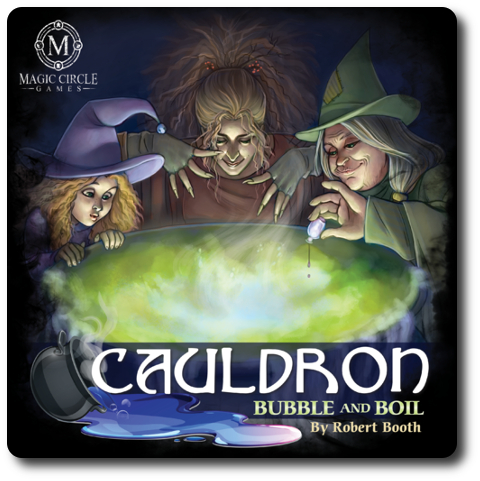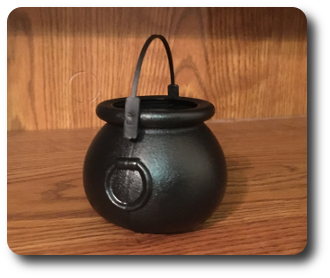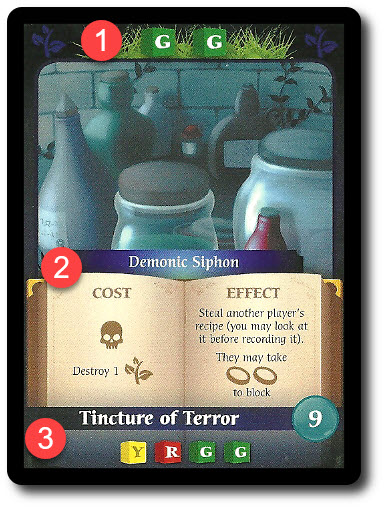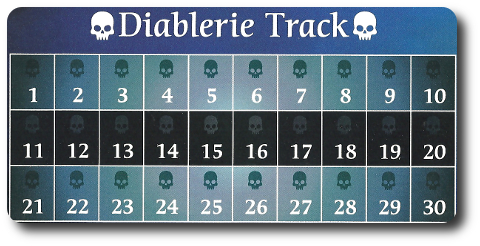Please Take Note: This is a review of the final game, but it might change slightly based on the success of the Kickstarter campaign. The game is being reviewed on the components and the rules provided with the understanding that “what you see is not what you might get” when the game is published. If you like what you read and want to learn more, we encourage you to visit the kickstarter campaign. Now that we have all that disclaimer junk out of the way, on with the review.

The Basics:
- For ages 12 and up
- For 2 to 4 players
- Approximately 60 minutes to complete
Geek Skills:
- Active Listening & Communication
- Counting & Math
- Logical & Critical Decision Making
- Reading
- Memorization & Pattern/Color Matching
- Strategy & Tactics
- Risk vs. Reward
- Hand/Resource Management
Learning Curve:
- Child – Moderate
- Adult – Easy
Theme & Narrative:
- Double, double toil and trouble; Fire burn and cauldron bubble…
Endorsements:
- Gamer Geek mixed
- Parent Geek mixed
- Child Geek mixed
Overview
A witch’s brew is full of nasty things. Eyes of newts, frog toes, and the occasional dirty gym sock. While the ingredients leave many gagging, the end result is always miraculous. Potions to make you fall in love, deadly poisons, and even a liquid to turn you invisible. In this game, you will attempt to perfect your potion skills and cast a spell or two along the way.
Cauldron: Bubble and Boil, designed by Robert Booth and to be published by Magic Circle Games, will reportedly be comprised of 1 scoreboard, 8 player markers (2 per player), 4 Cauldrons (actual miniature cauldrons), 4 Diablerie cards, 76 cards, 30 Crone tokens, 30 Corruption tokens, 32 Green cubes, 32 Orange cubes, 32 Red cubes, and 32 Yellow cubes. As this is a review of a prepublished game, I cannot comment on the game component quality. I will, however, comment on the mini cauldrons. They are awesome.

Adorable…
Let’s Get This Cauldron Bubbling…
To setup the game, first have each player select a player marker color and give each player a Diablerie track. One cube is placed on the victory point track found on the Diablerie card.
Second, reduce the total number of cubes in the game by determining the number of players. The more players there are in the game, the more cubes are used. Place any unused cubes back in the game box. Organize the cubes in play by color and into separate piles. This is referred to as the “resource pool”.
Third, give each player one cauldron and 1 cube of each resource. These resources are placed inside the player’s cauldron. From this point on, players can on longer look at their cauldron’s contents until the end of the game.
Fourth, shuffle the cards and deal five to each player, face-down. Place the remaining cards face-down and to one side of the game playing area. This is the draw deck. Leave room for a discard pile.
Fifth, place the Crone tokens and Corruption discs next to the resource pool.
That’s it for game setup. Determine who will be the first player and begin.
The Art of Cauldron Cuisine
Cauldron: Bubble and Boil is primarily card driven, where each card can be used several different ways. How they are used depends greatly on what the player’s current objects are and their overall strategy. The card anatomy is summarized here.

- The top most section of the card identifies what color and number of resource cubes the card provides if it’s used as part of the player’s “garden”. For this example, the card provides two green resource cubes.
- The middle section of the card identifies the “hex” (spell) that can be cast on an opponent. Included is the name of the hex, the cost, and its effect. For this example, the “Demonic Siphon” hex will increase the player’s Diablerie track value and require them to destroy one garden, providing the player an opportunity to grab another player’s card.
- The lower section of the card identifies the “recipe” that can be created using the noted resources. For this example, the “Tincture of Terror” requires one yellow, one red, and two green resources which will result in 9 victory points.
Eye of Newman, Toe of Todd…
Cauldron: Bubble and Boil is played in rounds and turns. A player’s turn is summarized here.
Note: A player is NEVER EVER EVER allowed to look in their cauldron or their opponent’s cauldron! Best remember what you put in, folks…
Hex a Player
The player adjusts their Diablerie (noted with a skull) track by +1 for each hex they want to cast. The Diablerie measure the player’s dabbling in the dark arts, which may or may not come back and bite them in the bud at the end of the game.

Each additional hex cast by the player will cost them 1 Corruption disc, which is determine by the total number of hexes already cast by the player this turn. The card used will determine the overall cost and there is no limit to the number of hexes a player can cast. Corruption discs go into the player’s cauldron and destroy resource cubes.
Any cubes taken from cauldrons are always taken at random, meaning a player blindly pulls them (no fair peeking!). Once the player casts the hex, the card is discarded.
Harvest a Garden
Take one cube from each card currently in the player’s “garden”. A garden is set of cards (two or more) that provide the same colored resource (or a wild). If a “garden” is ever reduced to only one card (through hexes, for example), the card is discarded.
If a player harvest all the cubes on their cards, the player discards the garden cards and earns one Crone token (which is worth victory points at the end of the game). Crone tokens are placed NEXT To the player’s cauldron. Not inside it.
Plant a Garden
The player adds to their set of cards that comprise their “garden”. Cards with matching resources are considered a single garden, regardless of the number of cards within it. The correct number and color of resource cubes are then placed on the cards.
A player is limited to only two gardens at a time. If a player wants to plant a new garden and two are already in play, they must destroy a previously made garden to make room. Destroyed gardens do not score the player points or provide resources and cost the player one Crone token if they have previously earned one. Gardens destroyed by hexes do not cost the player a Crone token (as they are being destroyed by an opponent instead of by choice).
Update Your Recipe Book
A player can optionally place one recipe card that they want to complete under their cauldron, face-down. All cards under a player’s cauldron are referred to as the player’s “recipe book”. Once a card is played to the player’s recipe book it CANNOT be examined by the player until the end of the game.
The only restriction here is the number of hexes the player has cast during their turn. If they have cast more than one on their turn, they CANNOT record their seventh recipe if it would trigger the end of the game. If the endgame has already been triggered, the player has no restrictions.
Discard and Draw
A player may optionally discard any number of cards they like from their hand and then draw back up to five cards in total. If the player already has five cards in their hand, then they only draw one card.
This completes the player’s turn.
My Cauldron Runneth Over…
The endgame is triggered if one or more of the following conditions are ever met:
- A player adds their seventh recipe
- When two resource cube piles are depleted from the resource pool
- The last Crone token in play is taken from the supply
- The last Corruption token is play is taken from the supply
- One or more players reach the top of their Diablerie track on their Diablerie card
The round ends as normal, ensuring all the players have the same number of turns during the game. At the end of the round, all gardens and resources that are still in play are discarded.
Players now score their individual playing areas as follows. Use the scoreboard to help keep track of the victory points earned:
- Each rank on the Diablerie track is worth 1 victory point
- The player with the highest Diablerie track score earns 5 victory points
- The player with the lowest Diablerie track score earn 10 victory points
- A player earns 3 victory points for each Crone token they have in their possession
- The player with the most number of Corruption tokens gains 5 victory points
- The player with the least number of Corruption tokens gains 10 victory points
- The player with the most of each resource earns 5 victory points per resource
And now it’s off to brew some potions for even more victory points!
For each potion recipe the player has, they now take the necessary resources and place them on the card. Each card and cube can only be used once. Each Corruption disc removes 1 resource cube from the cauldron. These should be set aside before brewing. After all available resources are allocated, score the victory points for the brews completed, adding the scores to the player’s previously earned victory points.
The player with the most victory points wins the game!
Game Variants
Lots of different ways to play this game. A few of the different methods are summarized here.
The Kindly Crone
This game variant allows the player to see the recipes they have collected (remaining face-up) making it easier to collect the right resource cubes. Whenever the deck of cards is shuffled, all players can briefly inspect what is in their cauldron. I recommend this variant be used the first time you play the game and with younger players.
Adjust Game Length
The game length can be altered by adjusting the required number of recipes to trigger the endgame. For example, a longer game would require 9 recipes while a shorter game would only require 5.
The Hard Stop
This game variant immediately ends the round when the endgame is triggered, removing the requirement that all players are given the same number of turns per game.
To learn more about Cauldron: Bubble and Boil, visit the kickstarter campaign.
Final Word
 The Child Geeks had difficulty with this game, primarily because there is so much going on in the game and a great deal that the player needs to keep track of. According to one Child Geek, “I like the idea of the game, but I only feel like I can play half of it. I can’t remember everything I put in my cauldron and I don’t know if I can complete my recipes that I’m keeping.” The game does require the player to remember a great deal. If a player doesn’t remember what they are putting in their cauldron, it makes it very difficult to determine which recipes to go after. A few Child Geeks came up with some tricks, though. As one Child Geek shared, “I don’t bother trying to remember everything that is in my cauldron. I use my garden cards to help me remember.” Smart. When all the games were over, the Child Geeks were split. The older and more experienced Child Geeks praised Cauldron: Bubble and Boil, while the younger and less experienced found the game to be too much work.
The Child Geeks had difficulty with this game, primarily because there is so much going on in the game and a great deal that the player needs to keep track of. According to one Child Geek, “I like the idea of the game, but I only feel like I can play half of it. I can’t remember everything I put in my cauldron and I don’t know if I can complete my recipes that I’m keeping.” The game does require the player to remember a great deal. If a player doesn’t remember what they are putting in their cauldron, it makes it very difficult to determine which recipes to go after. A few Child Geeks came up with some tricks, though. As one Child Geek shared, “I don’t bother trying to remember everything that is in my cauldron. I use my garden cards to help me remember.” Smart. When all the games were over, the Child Geeks were split. The older and more experienced Child Geeks praised Cauldron: Bubble and Boil, while the younger and less experienced found the game to be too much work.
 The Parent Geeks did not have the same level of difficulty learning the game, but they were just as confused at times. According to one Parent Geek, “You can easily lose track of what you’ve collected in your cauldron. I so desperately want to take a look in there to see what I have!” No, no, no! Don’t let your players do that! Part of the game’s challenge is to keeping everything you’ve done in your head so as to help you make it much less obvious to your opponents what you plan to do in the future. Another Parent Geek said, “I rather like the game, but I find it a bit too heavy for a game I’d want to play often.” Like the Child Geeks, the Parent Geeks were split when it came time to endorse Cauldron: Bubble and Boil. Roughly half found the game to be great mix of challenge and fun, while the other half found the game to be an exercise in stretched memory and sometimes futility.
The Parent Geeks did not have the same level of difficulty learning the game, but they were just as confused at times. According to one Parent Geek, “You can easily lose track of what you’ve collected in your cauldron. I so desperately want to take a look in there to see what I have!” No, no, no! Don’t let your players do that! Part of the game’s challenge is to keeping everything you’ve done in your head so as to help you make it much less obvious to your opponents what you plan to do in the future. Another Parent Geek said, “I rather like the game, but I find it a bit too heavy for a game I’d want to play often.” Like the Child Geeks, the Parent Geeks were split when it came time to endorse Cauldron: Bubble and Boil. Roughly half found the game to be great mix of challenge and fun, while the other half found the game to be an exercise in stretched memory and sometimes futility.
 The Gamer Geeks had no problem learning the game and getting into it, but they kept coming back to one of the game’s major mechanics. Specifically, memory. According to one Gamer Geek, “I think the game is fine, but I don’t know why it puts so much emphasis on memory. It makes the game feel a bit slow and overly burdens the player to keep track of a very important element of the game.” Another Gamer Geek said, “It is too easy to play this game blind, as you won’t be able to remember everything you put in your cauldron. For those players who do manage to keep track of everything in their head, this game is going to be a cakewalk.” Again, just like the Parent Geeks and the Child Geeks, the Gamer Geeks were split. Half of the gaming elitists found Cauldron: Bubble and Boil to be an interesting new take on resource gathering, card management, and memory that kept them busy, engaged, and challenged. The other half found the game to be of interest, but too heavy and awkward at times, making the overall game play frustrating and sometimes pointless.
The Gamer Geeks had no problem learning the game and getting into it, but they kept coming back to one of the game’s major mechanics. Specifically, memory. According to one Gamer Geek, “I think the game is fine, but I don’t know why it puts so much emphasis on memory. It makes the game feel a bit slow and overly burdens the player to keep track of a very important element of the game.” Another Gamer Geek said, “It is too easy to play this game blind, as you won’t be able to remember everything you put in your cauldron. For those players who do manage to keep track of everything in their head, this game is going to be a cakewalk.” Again, just like the Parent Geeks and the Child Geeks, the Gamer Geeks were split. Half of the gaming elitists found Cauldron: Bubble and Boil to be an interesting new take on resource gathering, card management, and memory that kept them busy, engaged, and challenged. The other half found the game to be of interest, but too heavy and awkward at times, making the overall game play frustrating and sometimes pointless.
 As for me, I found Cauldron: Bubble and Boil to be an intriguing mix of memorization and manipulation. You can easily mess with your opponent, but it costs you time and if you are playing with experienced players, time is one thing you don’t have much of. It’s easy to trigger the endgame, but downright difficult to make points.
As for me, I found Cauldron: Bubble and Boil to be an intriguing mix of memorization and manipulation. You can easily mess with your opponent, but it costs you time and if you are playing with experienced players, time is one thing you don’t have much of. It’s easy to trigger the endgame, but downright difficult to make points.
The scoring portion of the game is labor intensive at first and contributed to some of our players disliking Cauldron: Bubble and Boil. Players have lots of options which can make some players feel overwhelmed or underwhelmed, depending on their particular point of view. I personally found the scoring to be a bit difficult at first, as I would forget halfway through the game how a few points could be easily earned. But once you understand how the scoring is done, you will make much better decisions during your next game. I know this to be the case for all those who played the game with me and it was obvious that everyone who played the game a second and third time was a much stronger player than their first attempt at the game.
I rather liked the game for two reasons. First, the game gives the players a lot of power, but each choice a player can make is more beneficial than harmful. This means that even if you don’t know if the action you are taking will win you the game, it’s most certainly a step in the right direction. It doesn’t stop you from stumbling, but you will never fall flat on your face unless you make a really big mistake. Which brings me to the second reason I like this game. Having a good memory is a must. I found this to be very challenging and rewarding at the same time. It can be difficult to remember everything, so don’t, but you do have to remember enough to make smart choices. Again, the game puts a lot of power in the laps of the player, which can feel intimidating and stressful. It’s like learning how to drive on the interstate.
Some have reported that Cauldron: Bubble and Boil is easy to learn. I don’t agree. I think the basics of the game are easy to grasp, most certainly, but this is not a game that is easily understood. There is a lot to manage during the game. You have to keep remembering what resources you have gathered, which resources you have lost, gardens you have planted and plundered, the number of recipe cards your opponents have played and where you stand in the order of earning bonus points. This is not a game that opens up like a flower. It explodes in your face, overwhelming those who are not ready to be flooded with all the different ways to navigate the game.
I loved it.
Cauldron: Bubble and Boil isn’t going to win you over with its mini cauldrons, but do expect to be impressed with how challenging the game can be. A lot is put on the player’s shoulders that sometimes feels a bit too heavy to manage. But don’t let that get you down. I get the impression that the game is intentionally putting the pressure on you to force you to focus in and take control. This is not a game you can sleep through and nor is it a game you’ll want to half-ass. Cauldron: Bubble and Boil is demanding and rewarding for those who seek to tackle the challenge. Even if you don’t win the game, you’ll walk away from the table feeling like you accomplished something worth while.
This is a paid for review of the game’s final prototype. Although our time and focus was financially compensated, our words are our own. We’d need at least 10 million dollars before we started saying what other people wanted. Such is the statuesque and legendary integrity of Father Geek which cannot be bought except by those who own their own private islands and small countries.



